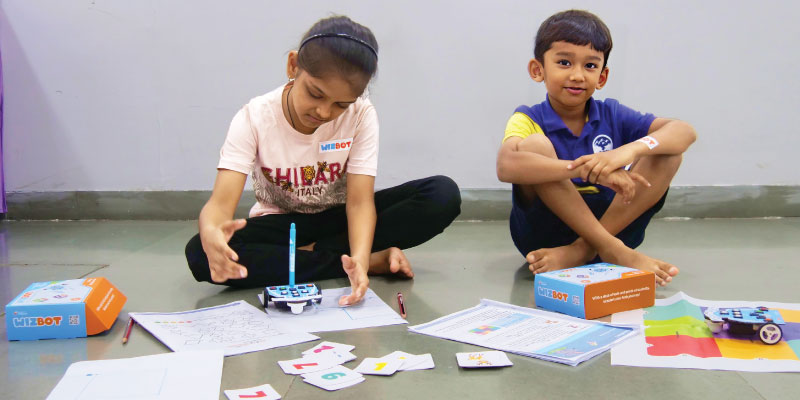Since the birth of STEM, robotics and electronics have taken a central place in the practice of STEM education. One can easily say that one of the best fields out there that can be an intersection of modern science, technology, engineering and mathematics is Robotics. Today, we look at Robotics with a STEM point of view and understand its subtle and not so subtle benefits.
But before we leap into what Robotics has in store for STEM students and perhaps students from all walks of life, we need to understand what is the scope of robotics being talked about here. The robotics here, in general, is referred to as the simplistic approach to the application of electronics that students in elementary and high school levels can cope with, and appreciate. This does not bring us to the AI dilemma we are all afraid of, and neither does it lead to a future portrayed by the Terminator franchise.
Moving on, Robotics in learning can entail a simple robot that abides the users’ commands in movement and does tasks that are fundamental in understanding the scientific and mathematical background of the concepts involved thereof. Hence, we look at a field that shall not only make students want to create more, but also be more and more imaginative about what they can do with the machines and what problems they can address. When it comes to robotics and STEM, the sky is the limit!
Why Robotics, though?
An Intersection of all STEM fields
Robotics, as mentioned above, is simply the finest field there is which is the intersection of science, tech, engineering, and math. From designing and programming to building a machine that does it’s user’s bidding is something that demands a highly interdisciplinary knowledge and makes the student go through a series of tasks based on learning by doing. Robotics, involving programming and electronics, is hence an integral part of STEM which acts as an embodiment of DIY and problem-based learning.
Learning by Doing
Apart from a direct DIY approach, we also have something which every DIY enthusiast goes through – learning from mistakes. Be it from the perspective of debugging, solving issues relating to the physical model of the bot, or simple tightening of the screws; the creator makes many mistakes and correcting them is indeed an important aspect of the learning curve. Say for example a small line following robot made can have issues in the logic of the code, the hardware, the setup and what not. This makes it important for the student to look for errors and solve them, on their own. This in its own right is something which can make better problem solvers than what conventional education brings to you.
Robotics and the Interdisciplinary Edge
For many students who are not exactly inclined to the fields of engineering and technology, robotics is indeed a plus. Learning programming in this ever fast developing world makes it important on how to learn to understand a machine. A doctor who knows his electronic equipment is always better than one who doesn’t! This makes STEM’s robotics important at the elementary level, where students can learn the basics of electronics, programming and robotics.
Implementation of Robotics
So how do you actually inculcate it in the curriculum?
One must understand that the amount of exposure to the students at an elementary level is something that should be judicious. The goal is to expose the students to the right kind of aspect of the problem while they see their curriculum’s theory become a practice right in front of them. Hence, we a carefully designed curriculum is required, or else the niche understandings can easily overwhelm a learner who isn’t ready. This also signals to the need of highly trained individuals who give away the right kind of training to the students.
Inculcating electronics, programming, and robotics also require access to the right kind of resources which enable the instructors to strike the right chords with the students and their appreciation for science. From Arduino to scratch programming, many tools make it accessible for the instructors to get a command over students and tap into their understanding.
Once hardware, instructors, and infrastructure have been taken care of by the institute or parents of the ward, comes the true implementation of robotics in schooling. STEM-based learning involves what we call experiential learning.
Here are a few ideas on how to implement the right kind of pedagogies, according to Makeblock:
Hold a contest based on which robot can complete a given task the best
In this activity, students are required to think creatively and maximize efficiency in their design. With AI implemented into robots like Codey Rocky, students have a lot more opportunities to get creative and innovate their own solutions.
Design a “Debugathon!” Whoever can find errors in the codes the quickest wins
Create a code that is supposed to perform a certain task. Then input some errors and have your students form groups to try and fix them. This exercise revolves around problem-solving and quick thinking as well as group work and leadership.
Allow students to design their own robot, make posters advertising its uses, and demonstrate it in front of the whole class
Creativity is the main skill being brought out in this activity with students thinking about how STEM can be applied to everyday uses. This is related to how the real tech world market works: Companies are looking for problems to solve through technology. Students will have to think about writing, presentation skills, and lastly, design.
STEMpedia and Robotics
STEMpedia’s love and appreciation for robotics is something that makes it a success in the schools which have taken up the services offered by us. STEMpedia solves all the issues that come with inculcation of STEM in regular school curricula. We have everything you need, from tailor-made courses and highly trained individuals to hardware that is needed to set up a robotics environment from the very first levels of education. STEMpedia’s evive Starter Kit is a one-stop solution. It has everything that a student needs to build robots and understand the robot and its function. For programming, we have a project-making mobile application called Dabble which makes it easy for the students to understand the logic of the code, but not be overwhelmed by the heavy niche understandings of the coding language that is not exactly required at the elementary and high school levels.

Well, we have everything that your ward needs to bring robotics in their life. Come visit us, and witness the magic.
In A Nutshell
Robotics and STEM are soon to become integral aspects of each other, owing to the strong intersection of fields in robotics. In this fastly developing world, technology has to be an important aspect of every highly trained individual. Adding robotics to the curriculum with tailor-made courses and careful integration can make students the builders of a better tomorrow. STEMpedia’s courses, tools and services can help cater all the needs of these builders under one roof.









